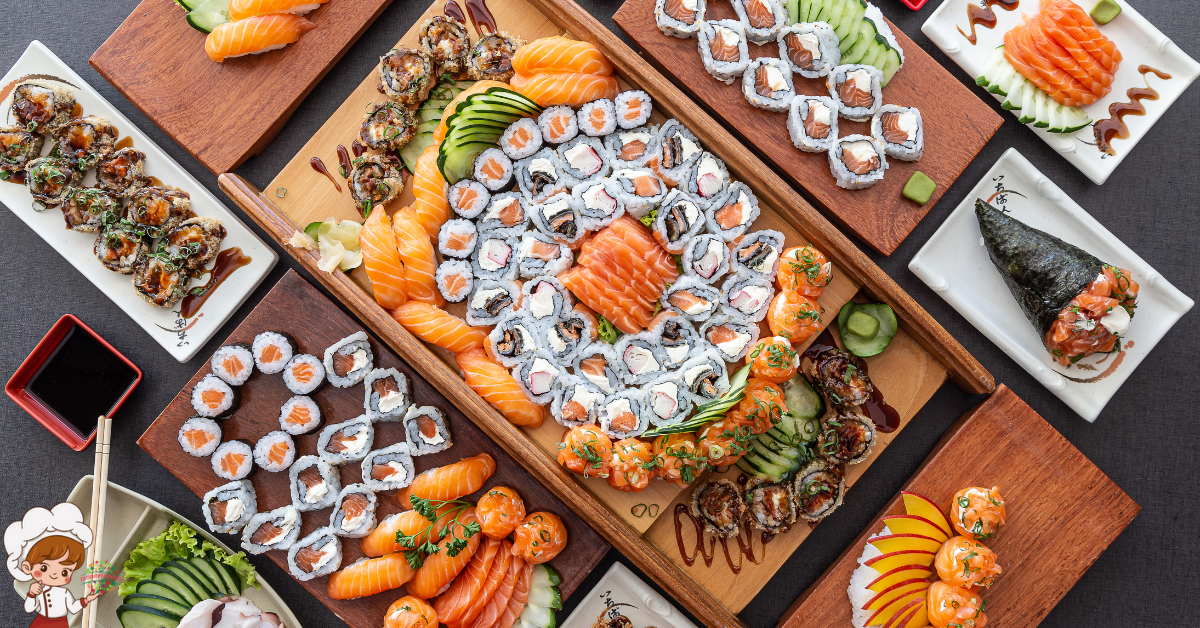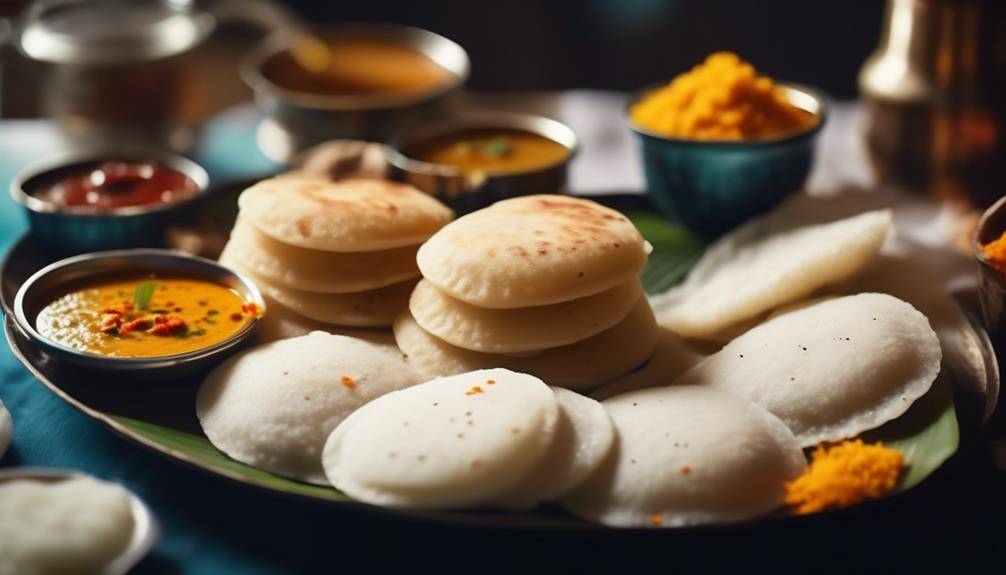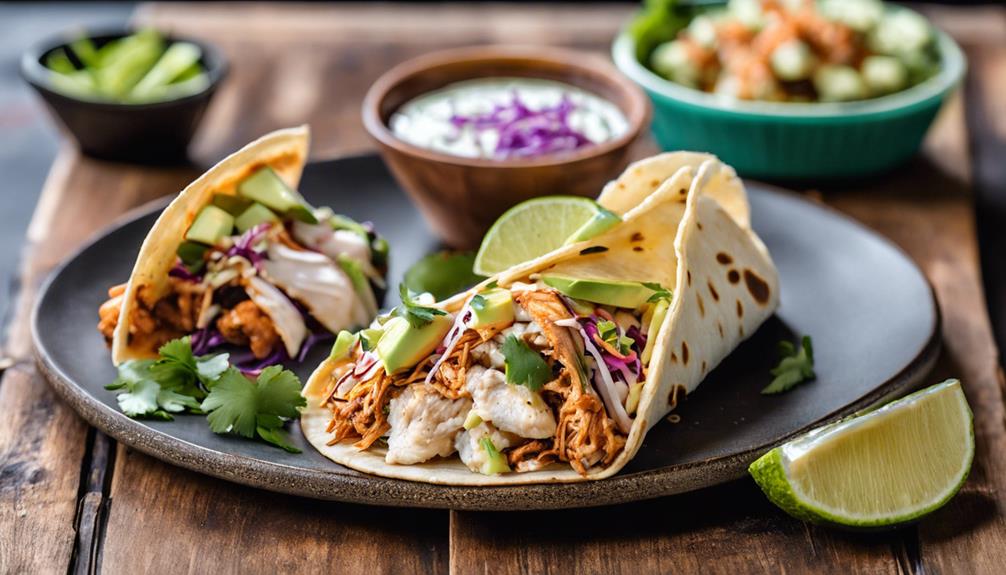The Exciting Origin of Quinoa and Vegetable Stir-Fry
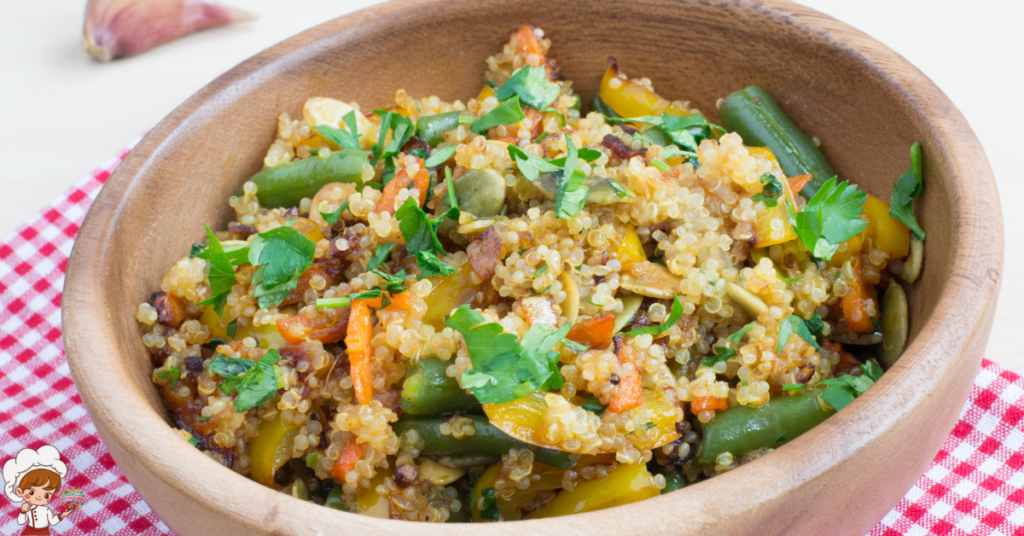
Origin of Quinoa and Vegetable Stir-Fry; In the world of plant-based cuisine, few dishes are as versatile and beloved as quinoa and vegetable stir-fry. This colorful, nutrient-packed meal combines the ancient grain quinoa with the global favorite technique of stir-frying vegetables. It’s quick, flavorful, customizable, and filled with health benefits. But while it may seem like a product of modern healthy eating trends, both quinoa and stir-fry have deep cultural roots and fascinating histories. This blog will explore how these two elements came together to create a beloved dish that bridges continents, traditions, and dietary preferences.
What is Quinoa?
Before we dive into history, let’s get familiar with quinoa (pronounced KEEN-wah). Often mistaken for a grain, quinoa is technically a seed, though it’s commonly classified as a “pseudo-grain” due to its cooking and nutritional similarities to grains. It belongs to the Chenopodium plant family, which also includes beets and spinach.
Quinoa is gluten-free, high in protein, and contains all nine essential amino acids, making it a complete protein source—a rarity in the plant world. Its nutty flavor and fluffy texture when cooked have made it a favorite in modern plant-based cooking.
The Ancient Roots of Quinoa
Quinoa has been cultivated for over 5,000 years in the Andes Mountains of South America, primarily in regions that are now Peru, Bolivia, and Ecuador. The Inca civilization referred to it as the “mother of all grains” and considered it sacred. According to legend, the Incan emperor would traditionally plant the first quinoa seeds of the season using golden tools.
This ancient seed thrived in the harsh, high-altitude conditions of the Andes and served as a crucial staple in the diet of pre-Columbian civilizations. Quinoa was not just a source of sustenance; it was intertwined with Andean spiritual beliefs and agricultural practices.
Spanish conquistadors, upon their arrival in the 16th century, suppressed the cultivation of quinoa in favor of European grains like wheat and barley, viewing indigenous crops and traditions as inferior. This led to a dramatic decline in quinoa production for centuries.
The Global Revival of Quinoa
Quinoa’s revival began in earnest during the late 20th century when scientists and nutritionists began to recognize its exceptional health properties. The 1980s saw experimental farming of quinoa outside South America, including in the United States, Canada, and parts of Europe.
In 2013, the United Nations declared it the “International Year of Quinoa,” acknowledging both its nutritional value and the indigenous communities who had preserved it for generations. Since then, quinoa has become a global phenomenon, embraced by vegetarians, vegans, and health-conscious eaters around the world.
Today, quinoa is a staple in everything from power bowls and salads to baked goods and breakfast porridge. Yet one of its most beloved modern applications is in stir-fries.
The Art of Stir-Frying
Stir-frying is a cooking technique that originated in China over 2,000 years ago, primarily during the Han dynasty (202 BC to 220 AD). The technique involves cooking food quickly over high heat while stirring constantly. This method preserves color, texture, and nutrients, making it ideal for vegetables.
The introduction of the wok revolutionized stir-frying, allowing for even heat distribution and minimal oil usage. Over time, stir-frying became a central technique in Chinese cuisine and spread to other parts of Asia, including Thailand, Vietnam, Korea, and Japan.
In the West, stir-frying gained popularity in the 20th century, especially as global migration brought Chinese culinary traditions to cities across North America and Europe. The method’s speed, efficiency, and ability to turn humble ingredients into flavorful meals made it an attractive option for home cooks.
How Quinoa and Stir-Fry Came Together
The fusion of quinoa and vegetable stir-fry is a relatively recent development, but it makes perfect culinary sense. As global interest in healthy, plant-based eating has grown, so has the popularity of combining traditional techniques and superfoods from different cultures.
Substituting quinoa for rice or noodles in stir-fry recipes offers a higher protein content and a distinct nutty flavor. Its fluffy texture pairs beautifully with crispy, sautéed vegetables and umami-rich sauces. The result is a satisfying, balanced meal that can be adapted to nearly any dietary need.
The quinoa vegetable stir-fry is now a staple in health food restaurants, meal prep plans, and home kitchens. It exemplifies the modern approach to food: culturally blended, nutritionally dense, and environmentally mindful.
Nutritional Benefits of Quinoa and Vegetable Stir-Fry
This dish is more than just trendy—it’s a nutritional powerhouse. Here’s a breakdown of its key health benefits:
- Complete protein: Quinoa provides all nine essential amino acids, ideal for vegetarians and vegans.
- Fiber-rich: Aids digestion and helps maintain stable blood sugar levels.
- Antioxidants: Vegetables like bell peppers, broccoli, and carrots are rich in vitamins A and C.
- Low glycemic index: Helps prevent blood sugar spikes.
- Gluten-free: Naturally safe for people with celiac disease or gluten sensitivity.
- Healthy fats: When cooked with sesame oil or avocado oil, you get a dose of heart-healthy fats.
Cultural Fusion and Global Appeal
The beauty of quinoa and vegetable stir-fry lies in its cultural fusion. It brings together:
- Andean tradition (quinoa)
- Asian cooking techniques (stir-fry)
- Modern dietary needs (plant-based, gluten-free, high-protein)
It’s a dish that symbolizes the global kitchen of the 21st century, where ingredients and techniques cross borders and create new culinary languages.
You’ll find versions of quinoa stir-fry in:
- Vegan cafés in Los Angeles
- Food stalls in London
- Organic bistros in Berlin
- Wellness retreats in Bali
Each version reflects local tastes and available produce, but the foundation remains the same: quinoa + colorful veggies + bold flavors.
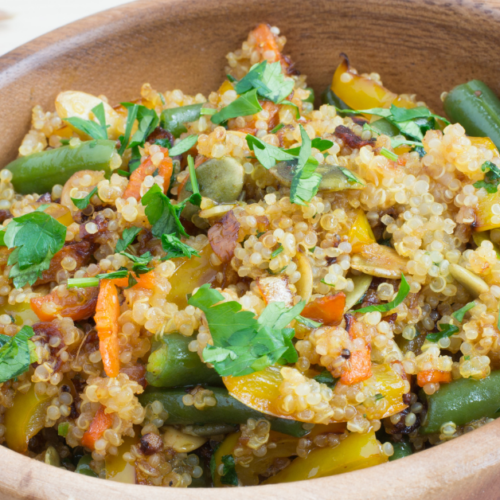
🌿 Easy Quinoa and Vegetable Stir-Fry Recipe
Ingredients
- 🧂 Ingredients:
- For the stir-fry:
- 1 tablespoon sesame oil or avocado oil
- 2 cloves garlic minced
- 1 tablespoon fresh ginger grated
- 1 red bell pepper sliced thin
- 1 yellow bell pepper sliced thin
- 1 medium carrot julienned or sliced thin
- 1 cup broccoli florets
- ½ cup snow peas or green beans
- 2 green onions sliced
- 2 cups cooked quinoa preferably cooled or day-old
- For the sauce:
- 3 tablespoons low-sodium soy sauce or tamari for gluten-free
- 1 tablespoon rice vinegar
- 1 tablespoon maple syrup or honey
- 1 teaspoon sriracha or chili garlic sauce optional for heat
- 1 teaspoon toasted sesame oil
- 1 tablespoon water
- Optional protein add-ins:
- ½ cup edamame cooked
- 1 block tofu pressed and cubed, pan-fried or baked
- 1 cup chickpeas roasted or sautéed
- Optional toppings:
- Chopped cilantro or basil
- Crushed peanuts or cashews
- Sesame seeds
- Lime wedges
Instructions
- 🔪 Instructions:
- Make the Sauce:
- In a small bowl, whisk together soy sauce, rice vinegar, maple syrup, sriracha (if using), sesame oil, and water. Set aside.
- Stir-Fry the Veggies:
- Heat 1 tablespoon of sesame oil in a large wok or skillet over medium-high heat. Add garlic and ginger, and sauté for about 30 seconds until fragrant.
- Add the Vegetables:
- Add bell peppers, carrots, broccoli, and snow peas. Stir-fry for about 5–7 minutes, until the vegetables are just tender but still crisp. Stir in the green onions and cook for 1 more minute.
- Add the Quinoa:
- Add the cooked quinoa and optional edamame or tofu to the pan. Pour the sauce over everything and stir to coat well. Cook for 2–3 more minutes until everything is heated through and the sauce is slightly absorbed.
- Serve:
- Remove from heat. Garnish with fresh herbs, nuts, sesame seeds, or a squeeze of lime. Serve hot.
Common Ingredients in Quinoa Vegetable Stir-Fry
While the variations are endless, here are some staples you’ll commonly find in a quinoa stir-fry:
- Cooked quinoa
- Bell peppers (red, yellow, green)
- Carrots
- Broccoli or cauliflower
- Snow peas or green beans
- Red onion or scallions
- Garlic and ginger
- Soy sauce, tamari, or coconut aminos
- Sesame oil or olive oil
- Tofu, tempeh, or edamame (optional)
Optional Toppings:
- Crushed peanuts or cashews
- Fresh cilantro or basil
- Sriracha or chili flakes
- Lime wedges
Sustainability and Ethical Eating
Quinoa and vegetable stir-fry also aligns with environmentally conscious eating. Plant-based diets tend to have a lower carbon footprint than meat-based diets, and quinoa can be grown sustainably in many climates.
However, it’s important to source quinoa ethically. The global demand for quinoa once led to economic strain in some Andean communities, so choosing fair-trade or locally grown quinoa can help support responsible farming practices.
Frequently Asked Questions (FAQ)
Q: Is quinoa healthier than rice in stir-fry?
A: Quinoa has more protein and fiber than white rice and is a complete protein, making it a more nutrient-dense option, especially for plant-based diets.
Q: Can I use leftover quinoa for stir-fry?
A: Absolutely! In fact, using day-old quinoa works great because it holds its texture better and doesn’t get mushy.
Q: What vegetables work best in a quinoa stir-fry?
A: Bell peppers, broccoli, carrots, snow peas, mushrooms, and zucchini are all excellent options, but you can use whatever is in season or in your fridge.
Q: Can I add protein to quinoa stir-fry?
A: Yes! Great plant-based options include tofu, tempeh, edamame, or even chickpeas. Non-vegetarian options might include chicken or shrimp.
Q: How do I prevent the stir-fry from being soggy?
A: Use high heat, don’t overcrowd the pan, and stir-fry vegetables in small batches if needed. Also, make sure your quinoa is well-drained and fluffy.
Conclusion: Origin of Quinoa and Vegetable Stir-Fry
Quinoa and vegetable stir-fry is more than just a quick, healthy dinner idea. It’s a dish that carries the legacy of two powerful food traditions: the sacred Andean grain cultivated for millennia, and the ancient art of stir-frying that has nourished generations across Asia.
Together, they create a meal that honors the past while embracing the future—nutritious, adaptable, sustainable, and globally loved. Whether you’re cooking for health, ethics, or pure flavor, quinoa and vegetable stir-fry delivers on every front. So next time you whip up a batch, remember: you’re not just cooking dinner. You’re part of a worldwide story that spans cultures and centuries.




